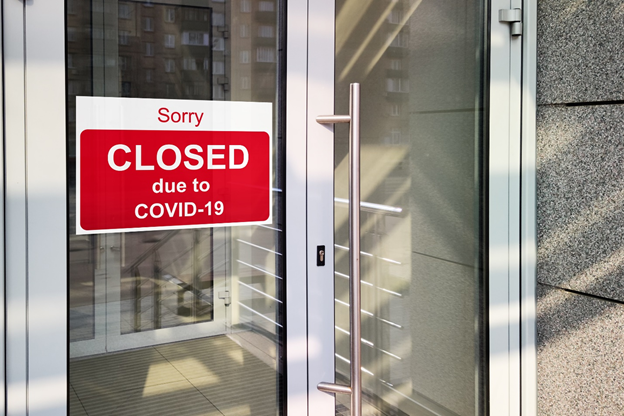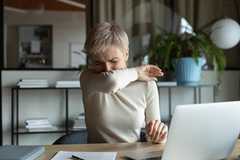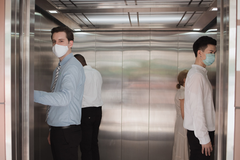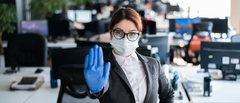- Home
- Products
- Blog
- Free Resources
- About Us
- Sample Pack
- My Stress Tools
- The Online Stress Profiler
- Empowering Employees Conference
- Sign in
No results found.
Stress Management, Well-being and Self-Care

by James Porter June 11, 2020
Someday, sooner for some than for others, we will all be returning to work. And that will bring on a whole new level of stress. How do we stay safe in the workplace (or just the outside world), when Covid19 is still an issue? How can we keep from stressing or even panicking about the prospect of coming back to a crowded workplace, where you have no idea, what hygiene or safety measures, others besides you, are taking?
As I have been saying in previous blogs on Covid19, we need to take control of what we can control and let go of what we can’t. And that applies to returning to work as much as it does to shopping at the grocery store or when taking a walk through your neighborhood. We all have to face the fact that we now live in a world that includes a deadly virus named Covid19.
Until someone creates a vaccine, that’s a variable that we can’t control: Just like we can’t really control many forms of cancer, car accidents, or the stock market. We’ve all learned how to live with these sources of pain and risk and still live a relatively satisfying life.
The answer is simple: Take precautions. Do everything you can do to minimize the risk and then, just as importantly: Learn how to be comfortable with that level of risk. You can significantly lower the risk of lung cancer by quitting smoking. You can significantly lower the risk of dying in a car accident by wearing your seat belt. You can significantly lower the risk of losing money on the stock market by diversifying your portfolio. That’s how most people get comfortable with risk: By lowering the odds that they will be affected by it.
Susan Jeffers wrote a best-selling book that many experts consider to be the self-help bible for how to deal with fear: “Feel the Fear and Do it Anyway.” In the opening chapter of her book she writes: “All you have to do to diminish your fear is to develop more trust in your ability to handle whatever comes your way.” She has five rules for dealing with fear. Rule #1 As long as you continue to grow, you will experience fear. Rule #2 The only way to get over a fear is to go out and do what it is you fear. As Jeffers further explains: “The doing it comes BEFORE the fear goes away.” And rule #3 directly addresses that problem: You will feel better about yourself to the degree you face your fear.
Rule #4 is we are all afraid of unfamiliar territory. And certainly, dealing with a worldwide pandemic is (except for a few Centenarians) completely unfamiliar territory. But rule #5 really clears up this issue completely: Pushing through fear is less uncomfortable than living with an underlying feeling of helplessness.
On some level we all know this contradictory-sounding advice is absolutely true. Still, if you have been holed up in your home or apartment – working remotely - for the last three months, then the idea of coming back into the world may sound frightening. Susan Jeffers wrote her book long before Covid19. How can we possibly apply these rules in situations where the potential cost of facing our fears might very well include, dying!

The way I would summarize Susan Jeffers landmark book for dealing with fear is, to the degree you are willing to face your fears, is the same degree to which they will eventually fade and disappear or at the very least become manageable. When I first read FEEL THE FEAR AND DO IT ANYWAY over a decade ago, I didn’t really believe this rule. And then I heard Frank Sinatra tell Larry King “I feel afraid every time I walk out on stage. But I know that after about five minutes the fear goes away.”
Since first reading the book, I’ve also met a psychiatrist who used to work for the New York Mets. Do baseball players ever get anxious I asked, playing in front of those huge crowds? “Of course they do he said, not hesitating for a second. “Pitchers are the worst. They get sick every time they have a big start. They vomit and have diarrhea which I can prescribe medications for. But I can’t give the players anything for anxiety. Imagine being out on a baseball field with hard objects flying toward you at one hundred miles an hour and you’ve taken medicine that dulls your senses. That would be dangerous.”
“Instead I teach them how to face that fear by converting their anxiety into increased energy and focus. It was a nice update on Susan Jeffers rule #5: Pushing through fear is less uncomfortable than living with an underlying feeling of helplessness. Susan Jeffers rules for dealing with fear are all well and good, you may be thinking, but it’s not the same as dealing with the fear of death. How do we deal with that fear for our mental well-being?
I started to understand this point much better after interviewing soldiers at Ft. Dix during the height of the Iraq war. All the soldiers I interviewed had been deployed to Iraq, multiple times. They all proudly wore a patch, sewed to their uniform, for having been deployed in a war zone. One guy I talked to had been deployed to Iraq five times. (That meant at least a total of five years spent in a war zone.) I asked him directly how do you deal with the fear of dying? To that question he answered: “We are all going to die someday. I’d rather face my fear and die attempting something heroic than die a premature death, let’s say in a car accident, having lived a life full of fear.”
During that same war I read an article about US Airforce fighter pilots who had made multiple “sorties” (bombing missions) over Iraq fearlessly avoiding anti-aircraft fire on every trip. These pilots believed in a concept called “The Big Sky Theory.” According to Wikipedia: “In aviation, the Big Sky Theory is that two randomly flying bodies are very unlikely to collide, as the three-dimensional space is so large relative to the bodies.”
To be honest, I think about the big sky theory now every time I go out for a walk. I am the plane and people’s corona virus germs are the anti-aircraft fire. As long as I’m out in open spaces with lots of air between me and others I TRUST that I will be safe. However, when I’m inside any building the Big Sky theory no longer applies. According to Wikipedia: “The Big Sky Theory does not apply when aircraft are flying along specific narrow routes, such as an airport traffic pattern or jet airway.” And that’s exactly what I think about when I’m inside or when considering going back into the workplace.
Here I’m taking a cue from an article I recently read in The New Yorker Magazine written by a surgeon who works at Brigham and Women’s Hospital, in Boston, Mass. Over the last two months, Boston has been a hot spot for the outbreak of the virus. The author makes the point that people returning to work should look at those front liners who never left work in the first place and have somehow managed to learn to LIVE safely with the risk. This is a quote from that article:

Unfortunately the fear of dying, is a lot more prominent now, than it was when Susan Jeffers wrote her book, long before Covid19. Still, many of her concepts still apply. And by looking at the experience of front-line employees, working in hospitals, who never LEFT the workplace, we can learn some very important lessons about returning to work as well.
According to the article in the New Yorker magazine, written by Atul Gawande, they have managed to almost (but not completely) contain the spread of the disease within the hospital due to four main practices we’ve all become familiar with, but maybe haven’t had to depend on to the degree that these front-line employees must:
He explains that all these methods can help but used in combination they have worked dramatically well in containing the virus. He adds little details in the article that help you understand the benefits of all these precautionary measures separately, but then explains why they work better in concert. For example, masks help to keep you safe, but not completely safe, so masks PLUS social distancing works better than just masks.
Washing hands works well but washing hands a LOT works better. (The author quotes a study done at a military boot camp where washing hands five times a day cut down visits to the infirmary for respiratory complaints by 50%.) The six-foot social distancing rule is good, (although arbitrarily chosen) but if someone explosively sneezes without covering up, those viral particles can travel up to twenty feet.
However, six feet away STILL keeps you relatively safe since it’s the area within about three feet that gets the VAST majority of the germ spread. So here again you will best be protected by a combination of precautions: Washing hands regularly throughout the day, wearing a mask and staying six feet away or more. So, you see how these precautions work in tandem better than they work alone.
He also talks about turning as many face-to-face meetings into zoom meetings as possible even when the person you need to talk to, works in the office adjacent to you. In other words, YOU STILL MEET ON ZOOM!
He writes: Having observers in place (presumably where lines form, and people gather) to gently remind people to keep their distance from each other is effective too. I was in the grocery store the other day, and a young fellow with a case of beer got in the line right behind me. The cashier gently reminded him to step back.
When face-to-face meetings are necessary putting a plexiglass barrier as is the case now at banks and grocery store check-out lines is helpful, too. The author also cites the fact that exposure time matters: “Less than 15 minutes spent in the company of someone with the virus makes spread unlikely.”
And if these 4 procedures work in a hospital to minimize spread, then you know they can work in an office or workplace, too.

Apparently, there’s almost a code of honor among hospital workers that you don’t call in sick, no matter what. I’ve seen this honor code in lots of other work environments as well. Certainly, it occurs in the military and in police work and in first responders of all types. This attitude prevails in many other workplaces as well. Nobody wants to let his or her fellow workers down. This seemingly courageous attitude however turns out to be fool-hardy in the context of a pandemic. Here’s why:
Epidemiologists talk about the reproductive ratio or “R0” (infection rate) of different types of disease. Measles has a scary R0 of 18. I remember my mother used to talk about how – when I was little - if one child in a family got measles, if the other siblings weren’t infants, the parents would deliberately expose them to the infected child, just to get the disease over with in one fell swoop. (It made sense: It wasn’t a deadly disease. And, without a vaccine, eventually (with such a high R0 Factor) all children were almost certain to get it, and why not have everybody get sick and staying home at the same time.)
The coronavirus isn’t nearly as contagious as the measles. However even an R0 of two is enough to cause a pandemic. In just days, those two people infect 4 people who infect 8 who infect 16 and already it starts to spiral out of control. You can totally grasp this multiplication factor by trying what Einstein liked to call a “thought experiment.” Take 1 penny and double it every day for just one month. By the end of the month you’ll end up with well over $1,000,000 dollars! And when you think about it, that $1,000,000 dollars is actually 100 million pennies. So, now you see how the Coronavirus, with an R0 of just 2, it can turn into a worldwide pandemic.
The only way to prevent this R0 from turning YOU into a statistic is by taking precautions. “Flattening the curve,” and limiting your exposure to the virus is what we’ve been hearing now for months. But now that states are reopening workplaces, what are workers supposed to do to stay safe and limit exposure? That’s where the experience at Brigham and Women’s Hospital becomes so useful. They never shut down AND managed to almost completely shut down the passing of the disease from patients to employees and from employees to other employees. One of the strategies the author of The New Yorker article mentions is an app that everyone who works at Brigham and Women’s Hospital in Boston must check in with every day before coming to work.
This app is very necessary to fight this urge to seemingly sacrifice one’s own health for the health of others when this is an absolutely counter-productive thing to do in the context of a pandemic. The app helps keep people honest with themselves and ultimately contributes to the safety of the group.
Any sign of disease means the employee MUST call in sick and stay home for at least 72 hours and all the symptoms go away or until they get tested negative for the virus. Chances are most workplaces won’t have access to such an app. But even if they don’t, they can still follow these very simple steps for assuring the safety of others which really amounts to calling in sick if you have any symptoms of Covid19 and waiting until you either get tested or the symptoms resolve.
My son works in a call center during the week, and as a professional musician at a large church on Sundays. Short of working directly with Covid19 in a hospital, these two (seemingly harmless) places turn out to be just about the worst places to work during a pandemic. And it sounds like he will be returning to work in both these places soon.
The article in The New Yorker cites the example of just ONE choir rehearsal that took place in Washington State, in March, before the lockdown but after people were aware of Covid19. No one hugged. No one coughed, but there was one member of the choir who was apparently asymptomatic and subsequently developed the virus. 32 members of the choir later tested positive for Covid19 and two died. Apparently when you sing, you are projecting not only your voice, but the virus germs too, well beyond the range of talking. The article also mentions that people talking loudly (think call centers) may spread the disease more readily than people talking softly.
So, the author says we must practice all the precautionary measures in combination: Washing hands frequently, disinfecting surfaces daily, wearing a mask, social-distancing, and using this app (or following the steps suggested by the app) which we described above. At the end of the article the author talks about a fifth thing he feels needs to be added to the list: A change in the culture of an organization.

“Culture eats strategy for breakfast, lunch and dinner.” This quote, often ascribed to world-famous management training strategist, Peter Drucker is surprisingly apropos to our discussion of returning to work while containing the spread of Covid19. As Atul Gatwande, explains in his article, “There needs to be a culture change in our organizations if we want to get back to work safely.” And as the Peter Drucker quote attests, strategy alone in this case, just doesn’t cut it.
Earlier we’ve talked about facing fear by reducing risk and how the four strategies of hygiene (washing hands frequently and sanitizing high-touch surfaces once a day), social distancing, self-screening for symptoms of Covid19 and wearing masks can be truly effective – when used in tandem -to prevent the spread of virus. These are effective strategies, but as the author points out, without a culture that supports these precautionary measures, they aren’t going to work nearly as well.
As he explains in the article, we need the unbending antiseptic culture that’s ALWAYS been present in the operating room to continue just as forcefully when we get out in the hallway.
But he laments, that he sees lapses, even in his own hospital, like when other doctors pull down their masks in order to hear each other talk in the hallway. Still, he’s reluctant to call them out on it. (That’s culture eating strategy for breakfast.) As he so accurately points out, we also need to be ok calling out lapses, AND be OK being called out on lapses, as well. (That’s a culture supporting strategy.)
Already our culture has changed to some extent. I see my neighbor and his guests, out in his backyard socializing and everyone is wearing a mask. He greets a tree guy working outdoors and all the workers are wearing scarfs over their faces and my neighbor is wearing a mask. In my hometown, I see 50 people lining up to get into Home Depot, all standing six feet apart. I see plexiglass shields at check-out counters in grocery stores. I see neighbors having parties with wine and cheese while staying on the opposite sides of their street. That’s a sea change; A paradigm shift, and that’s what is needed here.
The author mentions other things that organizations can do to safely bring workers back into the workplace while still affecting this cultural change: We need to encourage workers to stay home if they have ANY symptoms of Covid19 (until tested or all symptoms clear) giving them paid sick-leave or even topping off paid sick-leave if they are running short. (That would be a radical – but absolutely needed- cultural change.)
If we want to lower employees levels of stress, while returning to work, we need to give them a sense that these rules will be enforced at every level, and that the employees themselves don’t have to be the enforcers, or if they do, they will always be supported in their efforts. We talked in an earlier installment about having observers in place wherever a line forms or people gather to enforce the rules. I mentioned seeing a cashier doing this quite effectively in a grocery store. This feels to me like a cultural change as well.
Dr. Fauci says he hopes that the handshake will become a thing of the past, as it is notorious for spreading germs. And this very act of shaking hands, so endemic to our culture, reminds us that cultural shifts – even simple gestures like a handshake – can really be BIG changes indeed. But it also reminds us that different cultures have different traditions for what to do upon meeting another person. So as with wearing masks, we need to take a cue from Asian cultures, where instead of shaking hands, a bow, or the namaste gesture in India (a slight bow with hands in prayer) are ways of greeting people WITHOUT shaking hands AND practiced through much of the world.
And finally the biggest cultural shift we are going to need in these troubling times is to fully acknowledge that some members of society suffer to a much larger degree with Covid19 than others. And to make the playing field for survival of this deadly pandemic level for all people, no matter what their racial, religious or socio-economic background, we are going to need the biggest cultural shift of all. As the New Yorker article states in stark terms:
To everyone’s surprise, working in the Covid19 unit at the hospital, then is not the most likely place to contract the disease. It’s going home. And for some people, particularly people at the low end of the socio-economic scale, going home is a scarier place than for others.
Even patients who come to the hospital and stay for a while are not as potentially hazardous to others as the employees who come and go every day and live in neighborhoods of Boston where the disease is more prevalent. Apparently the four strategies of hygiene, social distancing, screening and wearing masks, has worked in tandem to really prevent the spread of virus WITHIN the hospital, but that may not be all that’s needed to make this strategy work outside the hospital. This is why testing, easy access to healthcare, giving workers additional paid sick-leave and making PPEs available to everyone, even those who can’t afford it, is so important.
And that may be the biggest cultural shift of all.


by James Porter January 22, 2021

by Erica Tuminski December 22, 2020
Sign up to get the latest on sales, new releases and more …
© 2025 StressStop.com.
StressStop/AudioVision LLC
James Porter
Author